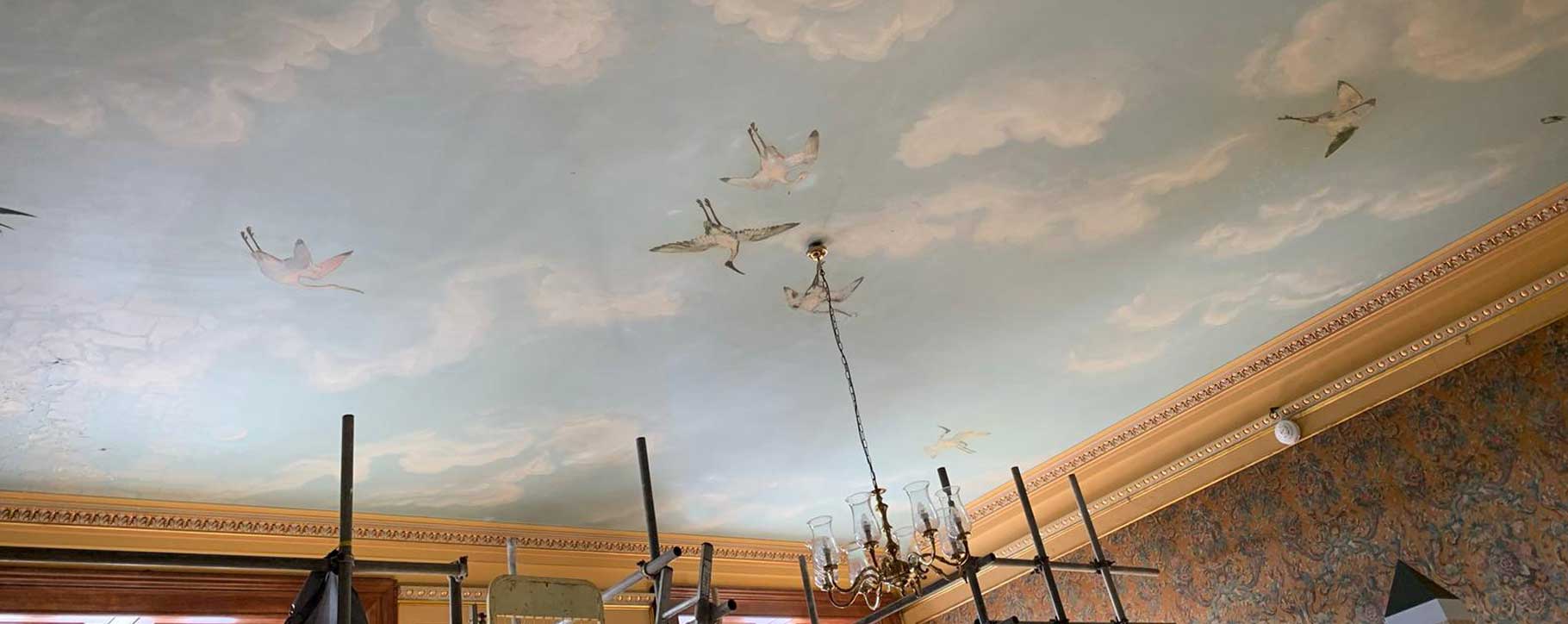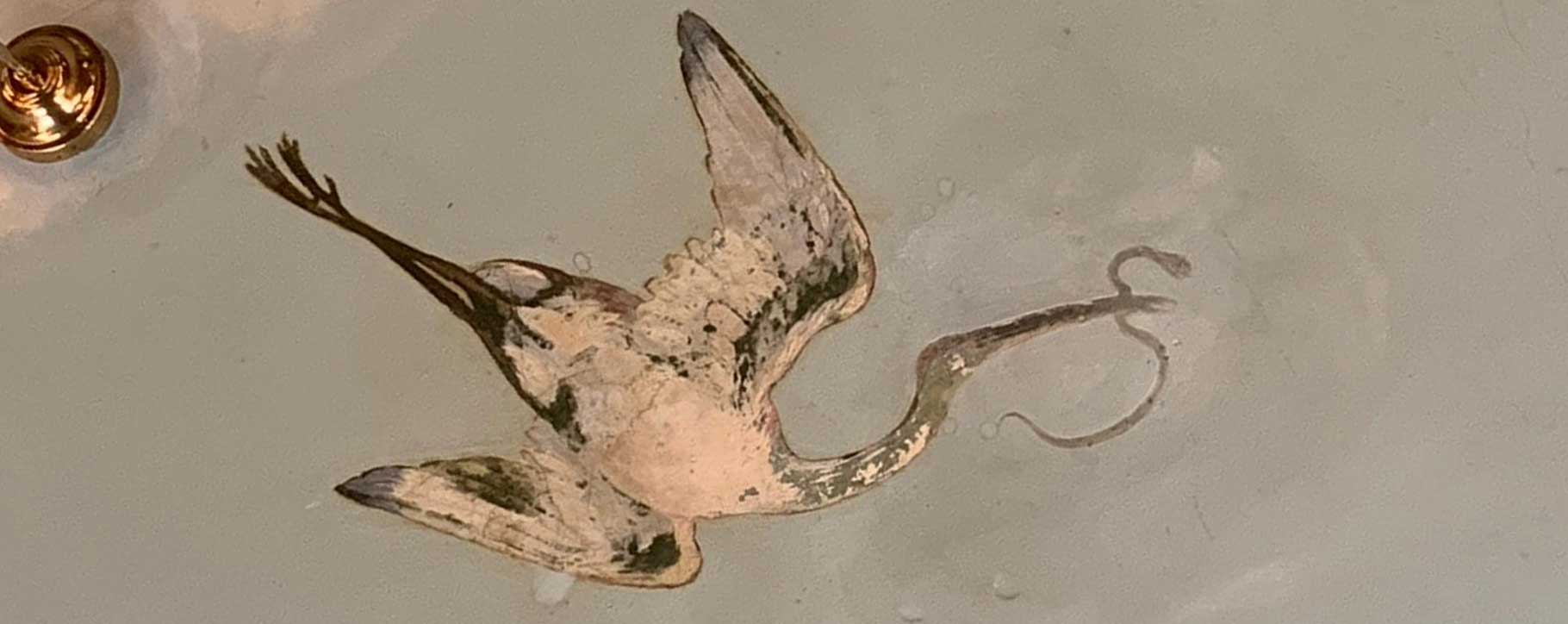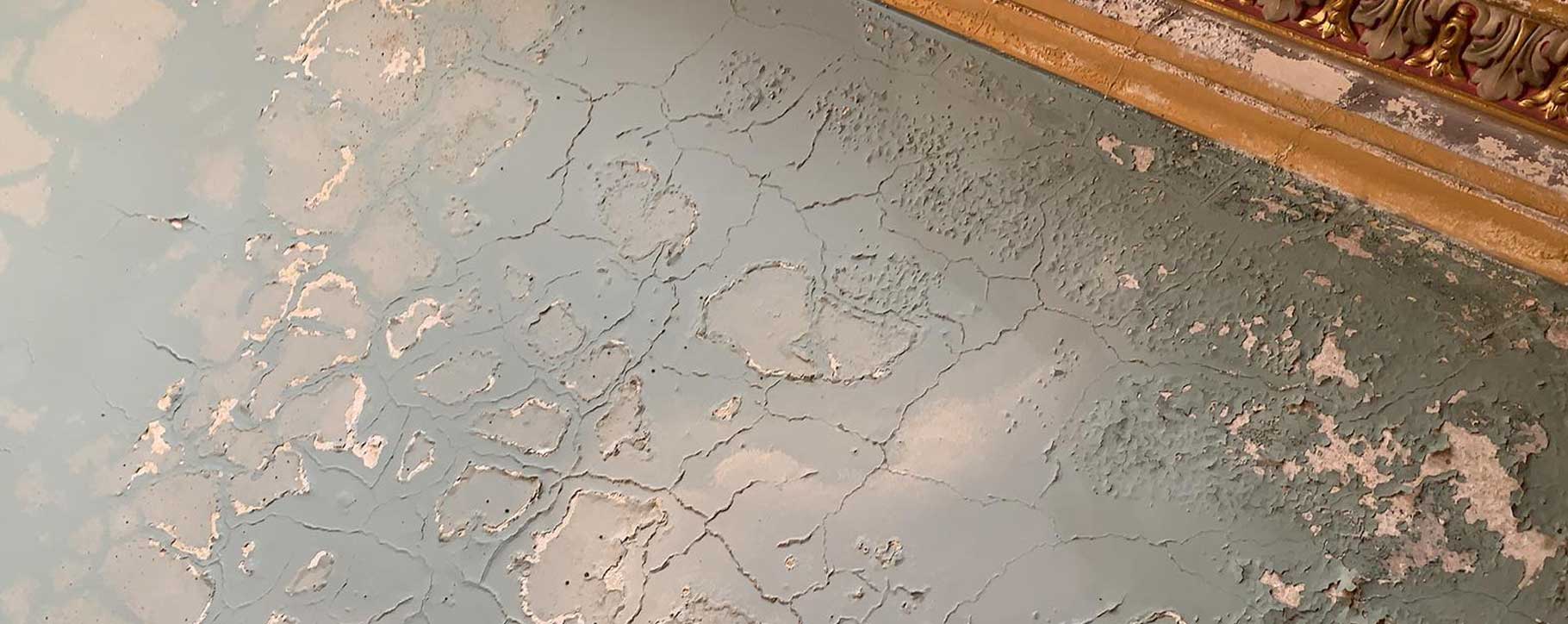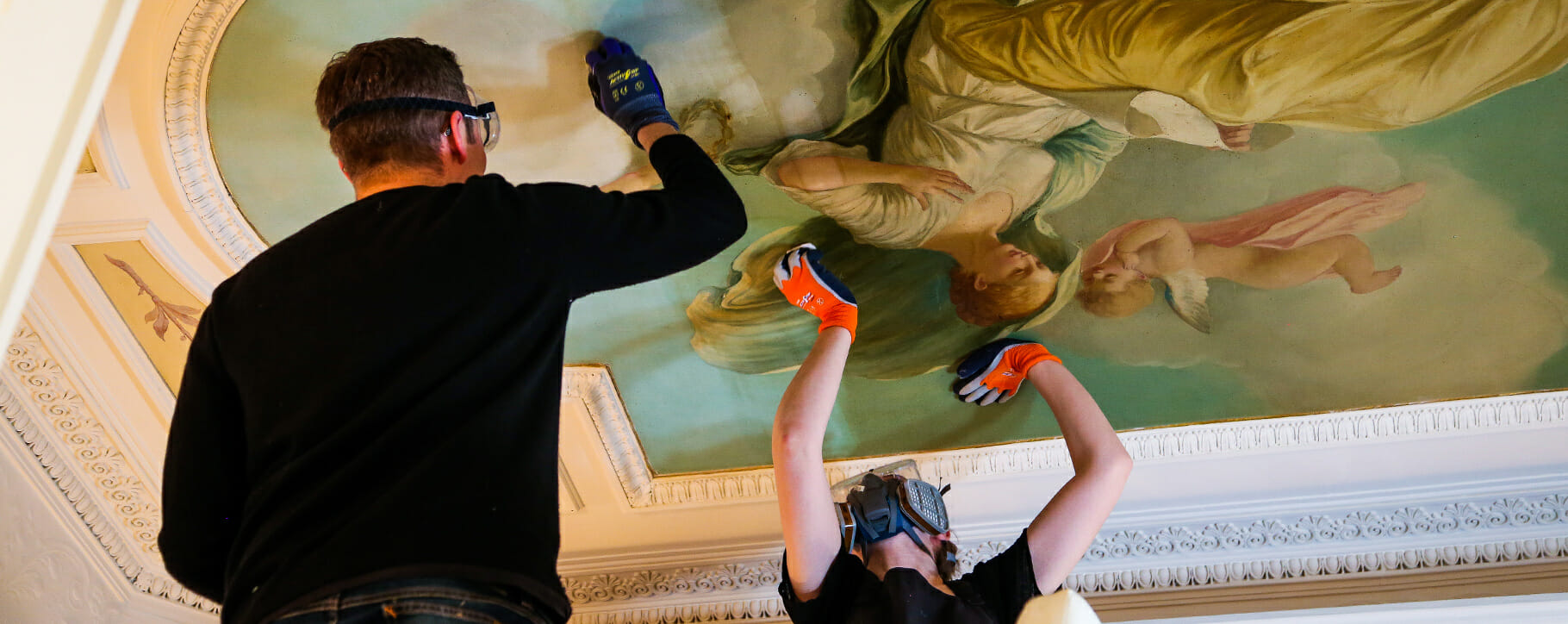When a leaking pipe, roof, wall or ceiling causes water damage to a property, all forms of art may be at risk. However, some may be more in more vulnerable positions than others. Whilst traditional oil paintings, watercolours, and important documents can be removed from an affected area, others are permanently left to face a growing amount of damage or disruption from the central issue or the invasive maintenance repairs which follow.
Murals on the walls and ceilings of a home, school or landmark are often unique in their design. The artistic and historic ties of such pieces can be significant to the location or have a wider cultural impact. Their preservation is important to the integrity of the architecture and the wider conservation of the building, especially if it is a listed property.
 Above: the ceiling during restoration treatment by our conservators
Above: the ceiling during restoration treatment by our conservators
When met with water damage, a mural can physically perish under the strain on the plasterwork, as well as facing discolouration, cracking and textural distortion. This was the case with a Victorian ceiling mural which was recently restored by our trained conservators. Our team was contacted about a leak which had discoloured areas of an important mural at Westonbirt School in Gloucestershire. Severe water damage had occurred on the 20ft high ceiling of the Oriel Room.
Grade I listed Westonbirt House was reconstructed in the early 19th century and again between 1863 and 1870, when the mural would have been commissioned.This grand home was reputed to be one of the most expensive houses constructed in the Victorian era. The mural was designed by the artist Alfred Morgan (1836-1924), whose original design for this specific ceiling is now on display at the Victoria and Albert Museum in London, making it culturally significant.
 Above: the stork holding a viper which features prominently in the mural, this had been previously over-painted to hide the viper
Above: the stork holding a viper which features prominently in the mural, this had been previously over-painted to hide the viper
Assessment and recommendations
The water damage had occurred over a period of time with some areas being more heavily affected than others. Our team of conservators visited Westonbirt House to analyse the extent of the issues which had been raised.
The greatest amount of water damage was to the south west corner of the piece, however there was also evidence of this occurring to the opposite corner to a lesser extent. Our conservators saw evidence of issues which are associated with water damage, such as an area of suspected blanching (mould), salts from the plaster leaching through and then crystallising, as well as fly spots (small dark spots of fly excrement) from a possible insect infestation in the past.
 Above: a detail from the water damaged ceiling with unstable paint and salts from the plaster leaching through and crystallising
Above: a detail from the water damaged ceiling with unstable paint and salts from the plaster leaching through and crystallising
The painting had been visually disturbed by the water damage, as well as being put into a vulnerable condition. Severe discolouration spread in areas of the work, making them appear darkened and yellowing.
Secondly, the natural cracks, or craquelure, of the artwork were under stress from the damage, with the paint peeling away from these fragile areas. Further locations of mould were found, as well as historic attempts at restoration which detracted from the original artwork. The past overpainting was most notably in the centre where the stork holds the viper in its beak, the viper had at some point been removed from the work and then later replaced back again.
 Above: a close-up of the crystallising effect which causes wide and disturbing cracks to the mural
Above: a close-up of the crystallising effect which causes wide and disturbing cracks to the mural
Our team put together a report detailing the condition as well as recommendations for several levels of restoration treatment for consideration. The first was to address only the most recent damage, one for the more historic issues, and the third for a full restoration of the ceiling. The latter would allow for a sensitive and seamless restoration to be taken out, addressing all areas of concern and ensuring the preservation of the piece with a conservation approach.
Preparing for the mural restoration
Whilst the restoration was considered, the school had to find the source of the leak itself, which took some time to locate and resolve, as the building is very old and more complicated than modern property. Additionally, it needed time to fully dry out. This was followed by personnel and ownership of the school. When COVID-19 arrived, there were further delays due to national lockdowns.
In November 2020, the school was able to go ahead with the long awaited restoration. In preparation, we conducted the appropriate health and safety assessments, provided the necessary DBS clearances, discussions on scaffolding requirements and logistics whilst patrons were on site, and the ever changing limits brought upon by the pandemic.
When our team of conservators arrived on site in early 2021, they were met with damage which had developed further over time. The paint was flaking in wider areas and patches on the ceiling had formed rounded chasms, uneven in their texture and reminiscent in scope of a topological map. This in part was due to the salts in the plaster leaching through and crystallising.
 Above: our conservator Fiona consolidating the cracked and unstable paint layer
Above: our conservator Fiona consolidating the cracked and unstable paint layer
Restoring the Victorian ceiling mural
Over the course of several days, with adverse weather outside, our conservators Martha and Fiona were able to visit the room to carry out a full conservation treatment on the 19th century mural. Both conservators have previous professional experience with mural conservation, working on both historic artworks and Banksy pieces which often require a wide range of unusual and challenging restoration needs.
Above: our conservators view during the restoration of the oriel room ceiling
Using appropriate scaffolding for the project to reach the artwork with a steady approach, the pair worked upon the areas of cracking and flaking paint. Their consolidation treatment re-adhered the paint to the plaster without any movement of the original artwork. A small injection of conservation adhesive was syringed into the gaps beneath the paint layer, this ensures that it is no longer at risk of falling away. The ceiling was sensitively cleaned of any areas of discolouration, fly spots, plaster salts or mould, including the pale blanched veil which had occurred due to damp conditions.
Above: the consolidation of the paint layer with a specialist solution which will stabilise the mural
Any areas of missing paint were gently filled in, to return an even surface to the ceiling. The colour was reapplied with conservation grade pigments. These pigments are importantly used instead of oil paints, as they will age at the same rate as the rest of the work, can be easily removed if required in the future, and will not be confused for the original artwork. Our conservators have a background in fine art and are able to use these skills to seamlessly match the colours and details to the original painting.
Above: the uneven and unstable areas are filled to smooth out and strengthen the ceiling, after they are retouched with layers of carefully colour-matched conservation pigments
The end result of the restoration will allow the Oriel Room to be returned to its former glory, bringing back the bright and natural scene which can now bring wonder to future generations. It will also provide artistic and historic integrity for the Grade I listed property, allowing for a clear and preserved insight into the ideas and styles of the Victorian age.
How to act when faced with a damaged mural:
- Act promptly.
- Find the cause of the damage and halt the issue (such as a leak or infestation).
- Contact our team as soon as possible.
- If possible, gather old photographs of the artwork to give an idea of what the piece looked like prior to the damage.
- If damage is caused by a leak, ensure the artwork is dried out naturally and not with heaters or industrial drying units.
To prevent the acceleration of decay, it is recommended that swift and rapid action is taken at the first signs of any problem. The faster conservation treatment can take place, the more of the original artwork will be saved, less intervention will be required, and the lower the costs will be for restoration.
 Above: our team cleaning a discoloured ceiling which has been contaminated with decades of smoke and nicotine
Above: our team cleaning a discoloured ceiling which has been contaminated with decades of smoke and nicotine
Our team is on call for any of your concerns or queries surrounding this type of conservation treatment, so please do not hesitate to get in touch if you have any reservations about the safety and security of murals, historic wallpaper, or any other type of interior artwork which may have faced accidental or household damage.
This is also the case for artworks which may be in need of swift intervention due to signs of natural or environmental deterioration (a disturbed paint layer, discolouration, loss of detail, etc.) as this will also allow them to be safely preserved before more drastic issues occur in the future.
Get in touch with our team
If you have an artwork in need of restoration or conservation treatment, please get in touch with our team today to discuss collaboration.
You can email [email protected] or calling 0207 112 7576.

 Above: the ceiling during restoration treatment by our conservators
Above: the ceiling during restoration treatment by our conservators Above: the stork holding a viper which features prominently in the mural, this had been previously over-painted to hide the viper
Above: the stork holding a viper which features prominently in the mural, this had been previously over-painted to hide the viper Above: a detail from the water damaged ceiling with unstable paint and salts from the plaster leaching through and crystallising
Above: a detail from the water damaged ceiling with unstable paint and salts from the plaster leaching through and crystallising Above: a close-up of the crystallising effect which causes wide and disturbing cracks to the mural
Above: a close-up of the crystallising effect which causes wide and disturbing cracks to the mural Above: our conservator Fiona consolidating the cracked and unstable paint layer
Above: our conservator Fiona consolidating the cracked and unstable paint layer Above: our team cleaning a discoloured ceiling which has been contaminated with decades of smoke and nicotine
Above: our team cleaning a discoloured ceiling which has been contaminated with decades of smoke and nicotine




